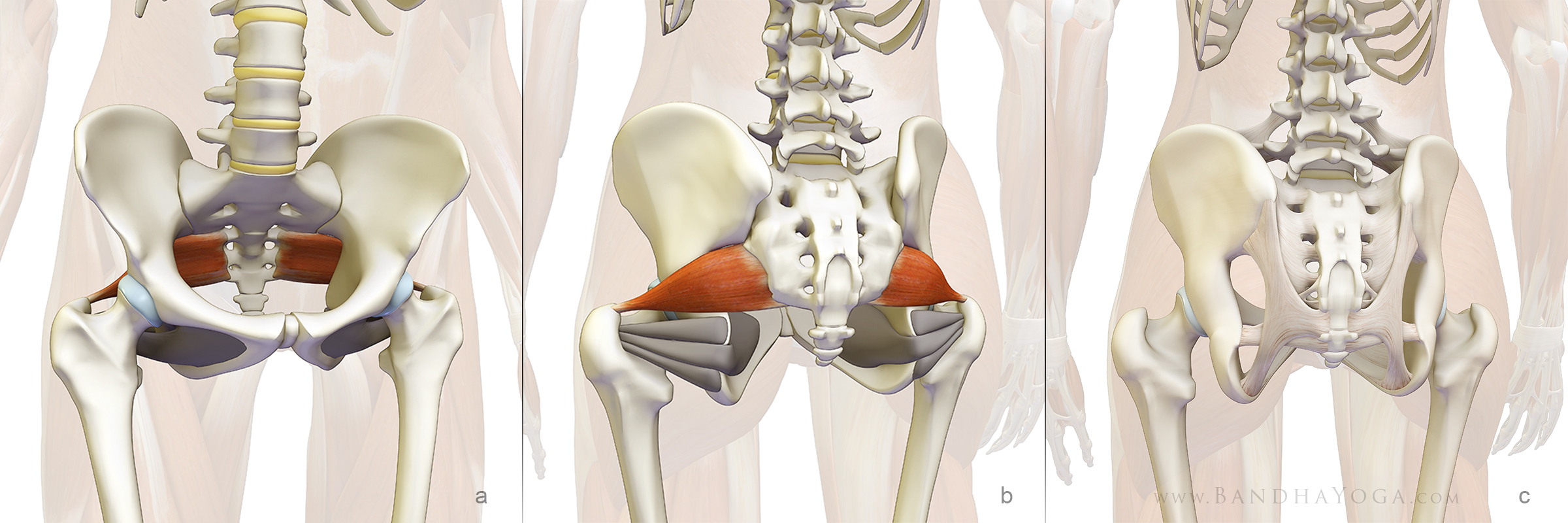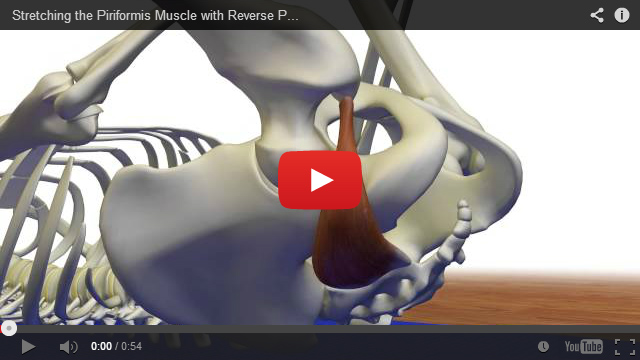「1枚の絵は1千語に匹敵する」といいます。ではもしその絵が3D動画だったら?このブログでは、3D動画を使って身体の中を映し出し、リバースピジョンポーズにおける梨状筋の状態、筋肉の基本的な働き、起始と停止、そして仙腸関節の安定について説明します。また、効果的なストレッチのための「関節リズム」についても考察していきます。
梨状筋は仙骨前面に起始し、大腿骨大転子に停止します。図1(a)と(b)は梨状筋を前後から見た図です。(c)は仙腸関節を安定させる太い靭帯です。
 |
図1:(a) 梨状筋を前から見た図 (b) 後ろから見た図 (c) 仙腸関節を安定させる靭帯
|
梨状筋は仙腸関節の安定筋です。そのため、梨状筋のアンバランスは骨盤の微妙な不均衡につながり、それが脊柱へ影響します。ヨガの練習では、梨状筋を左右バランス良くストレッチすることが大切です。仙腸関節と腰椎の安定筋については胸腰筋膜の記事を参照してください。関節の静的・動的な安定筋については「図解YOGAアナトミー・骨格編」および「図解YOGAアナトミー・アーサナ編」で詳しく説明しています。
リバースピジョンポーズが梨状筋のストレッチになぜ効果的なのか理解するために、この筋肉の働きが股関節の位置によって変わるという特性に注目する必要があります。たとえば、股関節がニュートラルな位置のとき、梨状筋は外旋(外側に回旋)、屈曲、外転します。股関節が60度を超えて屈曲すると、梨状筋は内旋、伸展、外転します。筋肉は、その働きと反対の方向に関節を動かすとストレッチされます。リバースピジョンポーズでは、股関節は屈曲、外旋するので梨状筋がストレッチされるのです(梨状筋はこの位置では股関節を伸展、内旋)。下の動画でストレッチの様子を見てみましょう。(クリックすると動画のウインドウが開きます)
動画では、背中を平らに伸ばすと仙腸関節にある梨状筋の起始が大腿骨の停止から引き離され、ストレッチがさらに促進されることがわかるでしょう。これは腰椎骨盤リズム、骨盤大腿リズムの一例です。動画の最後の部分では、仙骨の動きをわかりやすくするために骨盤の半分を隠し、この関節リズムのコンセプトを示しています。関節リズムについては過去のブログ”ヨガの練習で腰痛にならないためのヒント”をご参照ください。
図2は梨状筋のストレッチのバリエーションです。(a)は基本的なストレッチで、ヨガの練習でよく行われる方法です。(b)は、(a)のように深くストレッチするのが難しい人のためのバリエーションです。この方法では、腰を平らに伸ばす効果を体験できるでしょう。(c)は、大腿骨を内転、内旋して下側の足の梨状筋をストレッチします。(d)は、上側の足を内転(中心線に寄せる)して、大腿骨を外転する梨状筋の働きと逆方向にストレッチします。(e)は坐骨神経痛の原因にもなりうる梨状筋症候群の運動療法として、理学療法でよく用いられるバリエーションです(梨状筋症候群については別の記事で詳しく述べます)。このバリエーションは、上側の足を下側の足に完全に重なるように乗せ、大腿骨を内転して梨状筋をストレッチします。この方法は膝に不具合があって基本的なストレッチができない人に適しています。
私はこれらのストレッチを左右それぞれ20-30秒行います。ゆっくりポーズに入り、ゆっくり終了します。なぜ20-30秒なのか?その理由は”ハヌマナサナ/前後開脚”の記事で説明しています。このストレッチで(ほかのストレッチでも)痛みを感じたら、注意しながら慎重にポーズを終了します。坐骨神経痛などの症状がある場合は、症状の診断と適切な対応ができるヘルスケアの専門家に相談しながら行いましょう。専門家のガイダンスに従いながら、予防や治癒の助けとして適切な方法でヨガの練習をしましょう。
ブログを読んでくれてありがとう! Facebook、Twitter、Google Plusでぜひ記事をシェアしてください。また次のブログでお会いしましょう!
ナマステ
レイとクリスより
ブログを読んでくれてありがとう! Facebook、Twitter、Google Plusでぜひ記事をシェアしてください。また次のブログでお会いしましょう!
ナマステ
レイとクリスより



Thank you....as always you give me great information to share with my students that want and need great visual explanation. Pam Greenough
返信削除Excellent Pam--thanks for your support of our work! All the Best with your teaching~Ray
削除ty soooo much
返信削除:) Ray
削除Great information we will share in our teacher training this week in Edinburgh. Thank you as always. Namaste.
返信削除Thanks Anon--good luck with the TT! Ray
削除need workshops in the bay area
返信削除Hi Dolores,
削除Contact my assistant Carol and she'll help you set it up! carol@bandhayoga.com
Best~Ray
Great alternative for people who experience knee problems in this pose!
返信削除Hi Femke--yes, that works well and stretches the muscle too. Thanks for commenting~Ray
削除Ray & Chris - the format you use to present material is so useful and easily applicable. I absolutely loved the retreat at beautiful Blue Spirit Costa Rica last year; you couldn't have chosen a better spot. I learned so much and also got to enjoy myself at the same time. Will definitely do it again!
返信削除Namaste, Rachelle
Hi Rachelle--apologies for the delayed reply, was on the road. Great to see your comment. I love Blue Spirit too! Hope to see you there again. Best~Ray
削除What would I do without these periodic lessons? I get so much out of them. Now...how to download and print so I can share with students? Is there a way?
返信削除cer
Hi Anon,
削除Delighted that you enjoy the lessons. Check out the free E-book. It's in PDF so you can print as well. All the Best with your teaching! Ray
Brilliant!
返信削除Thank you. Seeing a video of the muscle moving makes it so much easier to understand how it actually works.
Thanks Anon! Ray
削除This info makes me much more confident about explaining the actions of the piriformis. Thanks!
返信削除Hi. I have been frustrated by the mechanics of this stretch for awhile, and thought that yoga teachers had made wrong assumptions. This gives actual understanding. Love y'all's approach, and look forward to studying with you in the future.
返信削除Good to hear, Joe. Yes, that stretch requires a bit deeper understanding of the action of the muscle to see how the stretch works. Most of the time we look at it as an external rotator, but the action changes in this position and that makes the stretch. Thanks for commenting! Ray
削除Wow! This is great. I have an older friend who suffers from sciatica which is apparently related to the piriformis. I'm hoping this explanation will be helpful to him.
返信削除Thanks Oriane! I find the video really helpful in understanding this. Good luck to you and your friend~Ray
削除Relevant, clearly explained & specific. Thankyou. Jane E Seymour
返信削除Thank you, Jane--much appreciated, that is how we try to make the blogs! Ray
削除The videos are a huge help. I know all of the names and locations, but to see it in action makes a big difference. Thanks for all you and Chris do.
返信削除Thanks Jonathan--good to hear you like the videos! Ray
削除Gratitude for sharing your vast knowledge!
返信削除You're welcome, Zaj~Ray
削除This is great, thank you so much for your posts. It really helps having the videos and visuals. I hope to be able to make it to your workshop one of these days!
返信削除Thanks Amita, delighted that you enjoy our work! Hope to see you at one of our workshops~Ray
削除Thank You for the details and descriptions. This is spectacular work.
返信削除Hello Paul--you're welcome. Many thanks for your compliment on our work! Ray
削除Woww..!!! I never see these type of videos.Awesome Videos ..Thanks Ray and Chris.
返信削除